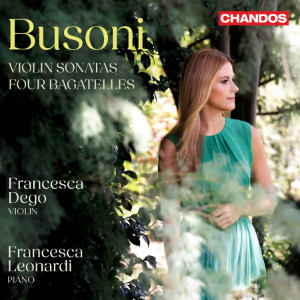
Ferrucio Busoni (1866-1924)
Violin Sonata No 1 in E minor, Op 29, BV 234 (1890)
Violin Sonata No 2 in E minor, Op 36a, BV 244 (1898, rev. 1900)
Four Bagatelles, Op 28, BV 229 (1888)
Francesca Dego (violin), Francesca Leonardi (piano)
rec. 2023, Potton Hall, Dunwich, Suffolk, UK
Chandos CHAN 20304 [65]
Ferrucio Busoni wrote his two violin sonatas about ten years apart, interestingly both in the key of E minor. They exemplify the first half of the composer’s career. The earlier sonata is still derivative, the later one more experimental. The regular duo of Francesca Dego and Francesca Leonardi play both works to perfection.
Busoni completed the Sonata No 1 when he was twenty-four; he already had written more than two hundred pieces. One of them, an early piano sonata, provides the five-note motif on which this work is based. It is heavily influenced by Brahms, with occasional appearances by Beethoven and Mozart, but it is Brahms with more flair than usual. The piano part is important, and in some ways more individualistic than that for violin. Especially notable is the lamenting quality of the second movement. The final Allegro deciso, the most distinctive movement, shows the composer absorbing the various influences.
As Antony Beaumont points out in his fine notes, the Sonata No 2 in one movement with multiple sections is formally based on Beethoven’s Piano Sonata No 30. It is much more modern than its predecessor. The opening langsam [slow] section, the longest, shows that the composer had built up an individual voice in the time since the first sonata. The next two sections beautifully develop the original material. The fourth section is based on a song from Anna Magdalena Bach’s notebook, though probably not by Bach himself. One of the highlights of the work is the soaring Poco piu andante section, a little reminiscent of Fauré. After two more light-hearted sections, we have the major slow section, beautiful and very expressive, followed by a section of contrapuntal development. The sonata is capped off by a monumental section which starts out Allegro but gradually slows down to the final restatement of the opening theme.
Busoni presented the Four Bagatelles, Op 28 to the seven-year-old Egon Petri. Egon was the son of Busoni’s friend, the famous violinist Henri Petri. He steered his obviously musical son towards his own instrument, but Egon would become an internationally known pianist. The delightful pieces give more of a workout to the pianist than the violinist.
The two Francescas – if I may – are quite a team, as can be seen in some of their previous recordings (review ~ review). Both must have given a lot of thought to these performances, full of passionate and forceful playing. I especially admired Francesca Dego’s beautiful phrasing and obvious love for Busoni’s music; she has recently recorded his Violin Concerto for Chandos (CHSA 5333). Clearly, I have not heard every available recording of the two sonatas, but I doubt that many outdo these two. An excellent disc by excellent performers.
William Kreindler
Buying this recording via a link below generates revenue for MWI, which helps the site remain free




















